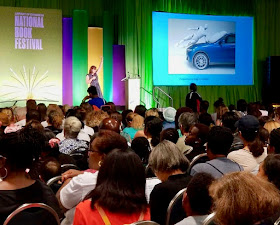Hi, I’m Evie, and I’m excited to tell you about a new book.
I love to jump, run, and win and I have the trophies and ribbons to prove it.
I was super excited and ready to compete in our school Field Day.
My friends kept winning and everyone cheered.
I was super excited and ready to compete in our school Field Day.
My friends kept winning and everyone cheered.
Except me.
I hate losing.
Finally, during the last race of the day, I was winning.
But something happened and I had to make a big decision.
You can read all about it in a new book starring me called:
EVIE’S FIELD DAY – More Than One Way to Win
Today is the day that I get to share the cover -
Ready,
set,
go -
set,
go -
I'm super excited for you to preorder here.
Now – here’s a few words from author Claire Annette Noland and illustrator Alicia Teba.
Claire, what inspired you to write Evie’s Field Day?
C.N. As a mom and teacher, I’ve seen first hand how hard it is for children to lose when playing games and sports. On the other hand, some winners aren’t very gracious. I wanted to write a story exploring the issue of sportsmanship and the old saying “it’s not whether you win or lose but how you play the game.” Children are under so much pressure these days. I just want them to be able to have fun and encourage each other.
Alicia, what about the text drew you to illustrate Evie’s Field Day?
A.T. I just fell in love with Evie's character. She is a strong and brave little girl who wants to be the best and number one in all she does. I related to this, as she wants to be perfect, but she finds that being perfect or the number one is not what really matters. It is good to win if you enjoy the process, but if you are sad and have anxiety you are doing it wrong. Playing is already winning and most importantly, little things in life bring you more happiness than winning a competition.
Claire, can you tell us about the road to publication for Evie’s Field Day?
I read a call for submissions from Maria Dismondy of Cardinal Rule Press. She was looking for manuscripts featuring children facing a problem. I knew I had a manuscript that fit her specifications so I sent it along. Amazingly, when I got “the call,” Maria shared that a friend had recently asked her if she had suggestions for a child who really struggled with losing. Then, my story came into her mailbox. Perfect timing, right?
I am really enjoying the process of publication with Cardinal Rule Press. The communication has been clear and frequent. I was able to participate in a marketing class taught by Maria and understand how much needs to happen for a successful book launch. I have redone my website and been trying to increase my social media presence. One of the most positive aspects of this adventure has been becoming a member of the 2020 Debut Crew which is a group of debut picture book authors working together to promote each other’s books.
Alicia, can you tell us a bit about how you illustrated Evie’s Field Day?
When Maria Dismondy from Cardinale Rule Press told me about the idea of using black and white and basic colors for the book, I loved the idea, as one of my favorite techniques is using pencil in a sketchy style.
Since I was little, I have always loved to draw. It is such a pleasure when I can work with characters and stories that move me and that can make me enjoy the process. This was definitely the case.
Congratulations Claire and Alicia! You are blue ribbon winners. Have a great run with Evie.
Congratulations Claire and Alicia! You are blue ribbon winners. Have a great run with Evie.
Thank so much, Janie, and the rest of the fabulous GROG bloggers for hosting the cover reveal. EVIE’S FIELD DAY – More Than One Way to Win (Cardinal Rule Press) will be racing to a bookshelf near you in May 2020.
Evie wants one lucky reader to have the opportunity to win a copy of Evie’s Field Day! Just leave a comment and a name will be chosen to receive the book when it is released in May of 2020.
Evie’s Field Day is available for preorder on Amazon:
Claire Annette Noland writes from her home in Central California. You can learn more at https://claireannettenoland.com/
Twitter: @claire_noland
Also, visit her blog at http://afieldtriplife.com/
Alicia Teba illustrates books, stationary, calendars, book covers and more from her home in Spain. You can learn more at
Instagram: https://garbancitaalicia.com/
Twitter: @AliciaTeba

















